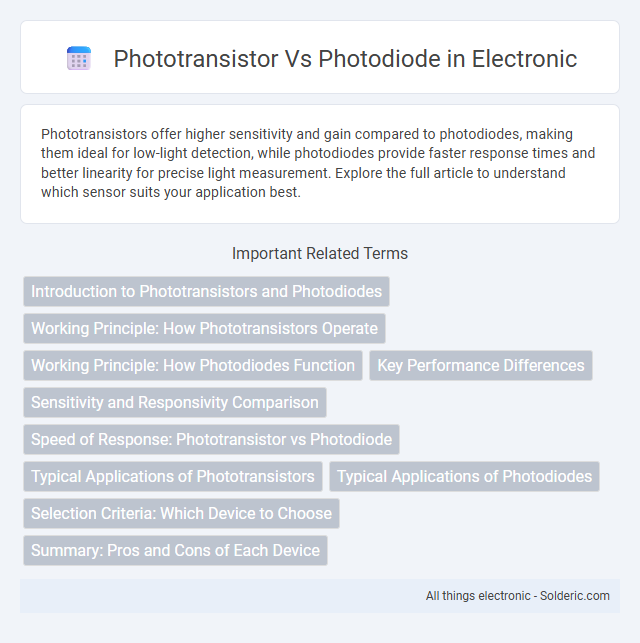Phototransistors offer higher sensitivity and gain compared to photodiodes, making them ideal for low-light detection, while photodiodes provide faster response times and better linearity for precise light measurement. Explore the full article to understand which sensor suits your application best.
Comparison Table
| Feature | Phototransistor | Photodiode |
|---|---|---|
| Operation | Amplifies current generated by light | Generates current directly proportional to light intensity |
| Sensitivity | High sensitivity due to internal gain | Lower sensitivity, requires external amplification |
| Response Speed | Slower response time (microseconds to milliseconds) | Faster response time (nanoseconds to microseconds) |
| Linearity | Less linear output | Highly linear response |
| Noise | More noise due to amplification | Lower noise with better signal accuracy |
| Typical Applications | Light detection in low-light, switching circuits | High-speed optical communication, precise light measurement |
| Cost | Generally low cost | Typically higher cost due to precision |
Introduction to Phototransistors and Photodiodes
Phototransistors and photodiodes are semiconductor devices that convert light into electrical signals, widely used in optical sensing applications. Photodiodes operate by generating a current proportional to the incident light intensity through the photovoltaic effect, offering fast response times and high sensitivity for precise light measurement. Phototransistors enhance sensitivity by amplifying the photocurrent internally, making them ideal for low-light detection but with slower response compared to photodiodes.
Working Principle: How Phototransistors Operate
Phototransistors operate by converting light into an electrical current through the photoelectric effect, where incoming photons generate electron-hole pairs in the base region, amplifying the current flowing from collector to emitter. Unlike photodiodes, phototransistors provide internal amplification, resulting in higher sensitivity and output signal strength. Your choice between the two depends on the required sensitivity, response speed, and application environment.
Working Principle: How Photodiodes Function
Photodiodes operate by converting light into electrical current through the photoelectric effect, where photons absorbed in the semiconductor material create electron-hole pairs. This generates a photocurrent proportional to the light intensity when the diode is reverse-biased, allowing precise light measurement. Phototransistors, in contrast, amplify this current internally, providing higher sensitivity but slower response times compared to photodiodes.
Key Performance Differences
Phototransistors offer higher sensitivity and gain compared to photodiodes, making them ideal for low-light applications where signal amplification is crucial. Photodiodes provide faster response times and lower noise levels, which suit high-speed and precision optical sensing tasks. Your choice between a phototransistor and photodiode depends on the required balance between sensitivity and response speed in your optical system.
Sensitivity and Responsivity Comparison
Phototransistors generally exhibit higher sensitivity than photodiodes due to their internal gain mechanism, allowing them to detect lower light levels more effectively. Photodiodes offer faster response times and greater linearity, making them more suitable for applications requiring precise light measurement. Choosing between the two depends on your need for sensitivity versus speed and accuracy in light detection.
Speed of Response: Phototransistor vs Photodiode
Photodiodes exhibit a faster response time compared to phototransistors due to their simpler structure and direct conversion of light into current, enabling high-speed applications such as optical communication. Phototransistors, containing an internal amplification mechanism, have slower response times caused by charge carrier recombination and transistor switching delays, making them better suited for low-speed or high-sensitivity tasks. Typical photodiode response times are in the order of nanoseconds, whereas phototransistor response times can range from microseconds to milliseconds.
Typical Applications of Phototransistors
Phototransistors are commonly used in light sensing applications requiring amplification, such as optical switches, remote control receivers, and light meters, where detecting low light levels is crucial. Their ability to provide higher sensitivity and gain makes them suitable for industrial automation and safety systems, including smoke detectors and position sensors. Your choice of phototransistor ensures enhanced performance in circuits needing both light detection and signal amplification.
Typical Applications of Photodiodes
Photodiodes are widely used in applications requiring precise and fast light detection, such as optical communication systems, barcode scanners, and medical instrumentation. Their ability to convert light into electrical signals with high sensitivity makes them ideal for low-level light sensing and laser range finding. Your projects can benefit from photodiodes' reliability in enhancing optical sensor performance and improving signal accuracy.
Selection Criteria: Which Device to Choose
Phototransistors offer higher sensitivity due to internal gain, making them ideal for low-light detection and applications requiring signal amplification, whereas photodiodes provide faster response times and better linearity suited for high-speed optical communication and precise light measurement. Selection depends on factors like response speed, sensitivity, spectral range, and noise performance; photodiodes excel in high-speed and high-accuracy environments, while phototransistors are preferred for cost-effective, low-light applications with moderate speed requirements. Device packaging, operating voltage, and required external circuitry also influence the optimal choice between phototransistors and photodiodes.
Summary: Pros and Cons of Each Device
Phototransistors offer higher sensitivity and gain compared to photodiodes, making them ideal for low-light detection, but they have slower response times and increased noise. Photodiodes provide fast response speeds and excellent linearity with low noise, suitable for high-speed and precise measurements, yet they require external amplification due to low output signals. Choosing between a phototransistor and a photodiode depends on the application's need for sensitivity versus speed and signal quality.
Phototransistor vs Photodiode Infographic

 solderic.com
solderic.com